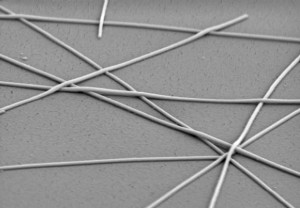



Feature Story
More feature stories by year:
2024
2023
2022
2021
2020
2019
2018
2017
2016
2015
2014
2013
2012
2011
2010
2009
2008
2007
2006
2005
2004
2003
2002
2001
2000
1999
1998
 Return to: 2015 Feature Stories
Return to: 2015 Feature Stories
CLIENT: CAMBRIOS
April 13, 2015: EE Catalog
By Sri Peruvemba, Cambrios Technologies Corporation
If designers struggled to make hard, flat products like notebooks and tablets survive constant wear and tear, the IoT's wearable products are a whole new game. Now a leap forward in materials for touch-enabled devices is increasing flexibility, a desirable feature for devices attached to humans.
What is already here in personal computing devices, in addition to mind-boggling electronics size reduction, is wearability. Making that happen means the human interface must radically evolve. Brittle glass is out. Flexible substrates are in. They provide enhanced portability and durability as well as allow virtually unlimited design freedom. Flexible touch displays essentially equate to great ergonomics.

Figure 1. It's expected that a wide variety of new products will exploit the design possibilities afforded by flexible screens. (Photo courtesy Cambrios Technologies Corporation)
Imagine unbreakable phone screens that flex instead of shattering when dropped. Consider folding a seven-inch tablet so it slips into your pocket. How about a display that wraps around your arm, or a huge public display wrapping around a pillar or a building like neon lighting does? We are driving toward products like these, and they are creating increasing demand for flexible, bendable and rollable touch screens. As more product designers become aware of silver nanowire enabled touch displays, we'll be seeing an increasingly diverse array of new products.
The next consumer electronic devices won't look like yesterday's clunky boxes. Tablets and laptops are becoming thinner, and even stationary products like monitors and kiosks are sleek and aesthetically pleasing, driving demand for thinner, lighter components. Electronic components with reduced mass tend to be more rugged and durable.
Breakthroughs in transparent electrodes based on silver nanowires are simplifying electronics manufacturing processes and improving end-product performance for current and next-generation consumer devices incorporating touch technology. Silver nanowires (Figure 2) are a key to applications in emerging growth markets. The flexibility, transmission and conductive properties of silver nanowires are enablers for an array of existing and forthcoming electronic displays, consumer wearables and IoT inventions for as-yet unimagined applications.

Figure 2. Magnified silver nanowires.
What makes silver nanowires a material ideally suited to the "touch age" are several factors. Touchscreens should be thin, light, visible in various ambient light conditions, highly responsive and (perhaps most important) lower-cost.
The most popular touchscreen technology is projected capacitance, or pro-cap. At the core of this technology is a transparent conductor, a layer of material that needs to conduct electricity while remaining transparent and allowing light from the underlying display to shine through the screen. Indium tin oxide (ITO), the legacy conductor material, is neither very conductive nor transparent compared with silver nanowire. It is also too brittle for flexible display and touch applications.
Forthcoming generations of much smaller or larger touch interface screens need to be very responsive. The display needs to be bright and visible in all types of ambient lighting. This requires notably more highly conductive transparent conductors with high transmission ability. Silver nanowire delivers on all counts.
Transparent conductors may also be applied as electrodes for LCD, OLED, thin film photovoltaic cells, shutters for 3D TVs and applications that are yet to be imagined. In general, the requirements are the same. This means higher conductivity, better light transmission and no side effects such as moiré or pattern visibility. Also needed: the flexibility to support bendable touch screens. OEM systems companies naturally want all of these features at less cost than traditional technology.
Single-layer touch sensors are in demand for tablets, mobile phones and whatever's next. A single layer approach offers much lower cost, with fewer layers of adhesives and conductors needed in the touchscreen stack. Newer products also have higher performance requirements to meet or exceed competitors, making silver nanowires an ideal fit.
Recently, a seven-inch true, single-layer design using silver nanowires was demonstrated. It's twice the size of what's possible with ITO. The narrow line/space requirements rule out competing metal mesh technologies as well. The seven-inch true single-layer touch sensor offers multi-touch capability, very high transmission (over 90 percent) and is precisely suited for most price-sensitive mobile consumer electronics products. This single-layer touchscreen can be matched with either a glass or plastic cover lens, offering OEMs notably increased product design capability.
Overall, silver nanowire-based touchscreens range from slightly less to significantly lower cost than equivalent ITO film-based solutions. This is partially because silver nanowires cost less to pattern using a room temperature laser process. This in turn allows higher throughput and quality similar to that achieved with high-end photo processing. Laser patterning roughly is one-fourth the cost of photo patterning because equipment costs are lower. Additionally the process requires no consumables like photo resist, etchants or strippers. Lastly, there are no waste disposal issues either. It's a greener way of making required materials used in new touchscreens.
Some names you've heard of. Silver nanowires are being adopted as the transparent-conductor-of-choice by leading industry heavyweights including Hitachi, LG, TPK, Nissha, 3M, Okura and many others. There isn't a downside. Overall, silver nanowire-based touch screen costs range from slightly less to significantly less than the cost of equivalent ITO, film-based solutions. The material is cost-effectively accelerating the transition to flexible and wearable devices.
 Sri Peruvemba is a vice president at Cambrios Technologies Corporation, which makes silver nanowire-based transparent conductors to simplify electronics manufacturing and improve end-product cost and performance for electronic devices. Cambrios is headquartered in Silicon Valley.
Sri Peruvemba is a vice president at Cambrios Technologies Corporation, which makes silver nanowire-based transparent conductors to simplify electronics manufacturing and improve end-product cost and performance for electronic devices. Cambrios is headquartered in Silicon Valley.
Return to: 2015 Feature Stories